Simultaneous Removal of As(III) and Fluoride Ions from Water Using Manganese Oxide Supported on Graphene Nanostructures (GO-MnO2)
Abstract
1. Introduction
2. Materials and Methods
2.1. Materials
2.2. Synthesis of GO, MnO2 and GO-MnO2
2.3. Analytical Determinations
2.4. Characterization Techniques
2.5. Adsorption Experiments
2.5.1. Equilibrium Experiments
2.5.2. Kinetics Experiments
3. Results and Discussion
3.1. Characterization
3.1.1. Scanning Electron Microscopy (SEM)
3.1.2. Fourier Transform Infrared Spectroscopy (FTIR) Analysis
3.2. Batch Adsorption Experiments
3.2.1. Effect of Adsorbent Dose and Comparison of Adsorbents
3.2.2. Effect of Initial pH Solution
3.2.3. Effect of Initial Concentration
3.2.4. Effect of Contact Time
3.3. Adsorption Isotherms
3.4. Adsorption Kinetics
3.5. Regeneration Study
4. Conclusions
Author Contributions
Funding
Institutional Review Board Statement
Informed Consent Statement
Data Availability Statement
Conflicts of Interest
References
- Chouhan, S.; Flora, S.J.S. Arsenic and fluoride: Two major ground water pollutants. Indian J. Exp. Biol. 2010, 48, 666–678. [Google Scholar] [PubMed]
- World Health Organization. World Health Organization European Standards for Drinking-Water. Am. J. Med. Sci. 1970, 242, 56. [Google Scholar]
- Smith, A.H.; Steinmaus, C.M. Health effects of arsenic and chromium in drinking water: Recent human findings. Annu. Rev. Public Health 2009, 30, 107–122. [Google Scholar] [CrossRef] [PubMed]
- Trikkaliotis, D.G.; Ainali, N.M.; Tolkou, A.K.; Mitropoulos, A.C.; Lambropoulou, D.A.; Bikiaris, D.N.; Kyzas, G.Z. Removal of Heavy Metal Ions from Wastewaters by Using Chitosan/Poly(Vinyl Alcohol) Adsorbents: A Review. Macromol 2022, 2, 26. [Google Scholar] [CrossRef]
- Arya, S.; Subramani, T.; Vennila, G.; Karunanidhi, D. Health risks associated with fluoride intake from rural drinking water supply and inverse mass balance modeling to decipher hydrogeochemical processes in Vattamalaikarai River basin, South India. Environ. Geochem. Health 2019, 43, 705–716. [Google Scholar] [CrossRef] [PubMed]
- Alarcón-Herrera, M.T.; Martin-Alarcon, D.A.; Gutiérrez, M.; Reynoso-Cuevas, L.; Martín-Domínguez, A.; Olmos-Márquez, M.A.; Bundschuh, J. Co-occurrence, possible origin, and health-risk assessment of arsenic and fluoride in drinking water sources in Mexico: Geographical data visualization. Sci. Total Environ. 2020, 698, 134168. [Google Scholar] [CrossRef]
- Katsoyiannis, I.A.; Zouboulis, A.I. Comparative evaluation of conventional and alternative methods for the removal of arsenic from contaminated groundwaters. Rev. Environ. Health 2006, 21, 25–41. [Google Scholar] [CrossRef]
- Katsoyiannis, I.A.; Voegelin, A.; Zouboulis, A.I.; Hug, S.J. Enhanced As(III) oxidation and removal by combined use of zero valent iron and hydrogen peroxide in aerated waters at neutral pH values. J. Hazard. Mater. 2015, 297, 1–7. [Google Scholar] [CrossRef] [PubMed]
- Cullen, W.R.; Reimer, K.J. Arsenic Speciation in the Environment. Chem. Rev. 1989, 89, 713–764. [Google Scholar] [CrossRef]
- Aposhian, H.V.; Zakharyan, R.A.; Avram, M.D.; Kopplin, M.J.; Wollenberg, M.L. Oxidation and detoxification of trivalent arsenic species. Toxicol. Appl. Pharmacol. 2003, 193, 1–8. [Google Scholar] [CrossRef]
- Farooqi, A.; Masuda, H.; Firdous, N. Toxic fluoride and arsenic contaminated groundwater in the Lahore and Kasur districts, Punjab, Pakistan and possible contaminant sources. Environ. Pollut. 2007, 145, 839–849. [Google Scholar] [CrossRef]
- Ingallinella, A.M.; Pacini, V.A.; Fernández, R.G.; Vidoni, R.M.; Sanguinetti, G. Simultaneous removal of arsenic and fluoride from groundwater by coagulation-adsorption with polyaluminum chloride. J. Environ. Sci. Health-Part A Toxic/Hazardous Subst. Environ. Eng. 2011, 46, 1288–1296. [Google Scholar] [CrossRef] [PubMed]
- López-Guzmán, M.; Alarcón-Herrera, M.T.; Irigoyen-Campuzano, J.R.; Torres-Castañón, L.A.; Reynoso-Cuevas, L. Simultaneous removal of fluoride and arsenic from well water by electrocoagulation. Sci. Total Environ. 2019, 678, 181–187. [Google Scholar] [CrossRef] [PubMed]
- Tolkou, A.K.; Meez, E.; Kyzas, G.Z.; Torretta, V.; Collivignarelli, M.C.; Caccamo, F.M.; Deliyanni, E.A.; Katsoyiannis, I.A. A Mini Review of Recent Findings in Cellulose-, Polymer- and Drinking Water. C—Journal Carbon Res. 2021, 7, 74. [Google Scholar] [CrossRef]
- Tolkou, A.K.; Manousi, N.; Zachariadis, G.A.; Katsoyiannis, I.A.; Deliyanni, E.A. Recently developed adsorbing materials for fluoride removal from water and fluoride analytical determination techniques: A review. Sustainability 2021, 13, 7061. [Google Scholar] [CrossRef]
- Laskaridis, A.; Sarakatsianos, I.; Tzollas, N.; Katsoyiannis, I.A. Simultaneous removal of arsenate and chromate from ground- and surface- waters by iron-based redox assisted coagulation. Sustainability 2020, 12, 5394. [Google Scholar] [CrossRef]
- Qiao, J.; Cui, Z.; Sun, Y.; Hu, Q.; Guan, X. Simultaneous removal of arsenate and fluoride from water by Al-Fe (hydr)oxides. Front. Environ. Sci. Eng. 2014, 8, 169–179. [Google Scholar] [CrossRef]
- Tolkou, A.K.; Kyzas, G.Z.; Katsoyiannis, I.A. Arsenic(III) and Arsenic(V) Removal from Water Sources by Molecularly Imprinted Polymers (MIPs): A Mini Review of Recent Developments. Sustainability 2022, 14, 5222. [Google Scholar] [CrossRef]
- Luo, X.; Lei, X.; Cai, N.; Xie, X.; Xue, Y.; Yu, F. Removal of heavy metal ions from water by magnetic cellulose-based beads with embedded chemically modified magnetite nanoparticles and activated carbon. ACS Sustain. Chem. Eng. 2016, 4, 3960–3969. [Google Scholar] [CrossRef]
- Rahaman, M.; Das, A.; Bose, S. Development of copper—Iron bimetallic nanoparticle impregnated activated carbon derived from coconut husk and its efficacy as a novel adsorbent toward the removal of chromium (VI) from aqueous solution. Water Environ. Res. 2021, 93, 1417–1427. [Google Scholar] [CrossRef]
- Kyzas, G.Z.; Tolkou, A.K.; Al Musawi, T.J.; Mengelizadeh, N.; Mohebi, S.; Balarak, D. Fluoride Removal from Water by Using Green Magnetic Activated Carbon Derived from Canola Stalks. Water Air Soil Pollut. 2022, 233, 424. [Google Scholar] [CrossRef]
- Meez, E.; Tolkou, A.K.; Giannakoudakis, D.A.; Katsoyiannis, I.A.; Kyzas, G.Z. Activated Carbons for Arsenic Removal from Natural Waters and Wastewaters : A Review. Water 2021, 13, 2982. [Google Scholar] [CrossRef]
- Bibi, S.; Farooqi, A.; Hussain, K.; Haider, N. Evaluation of industrial based adsorbents for simultaneous removal of arsenic and fluoride from drinking water. J. Clean. Prod. 2015, 87, 882–896. [Google Scholar] [CrossRef]
- Jadhav, S.V.; Bringas, E.; Yadav, G.D.; Rathod, V.K.; Ortiz, I.; Marathe, K.V. Arsenic and fluoride contaminated groundwaters: A review of current technologies for contaminants removal. J. Environ. Manage 2015, 162, 306–325. [Google Scholar] [CrossRef] [PubMed]
- Gupta, A.R.; Joshi, V.C.; Yadav, A.; Sharma, S. Synchronous Removal of Arsenic and Fluoride from Aqueous Solution: A Facile Approach to Fabricate Novel Functional Metallopolymer Microspheres. ACS Omega 2022, 7, 4879–4891. [Google Scholar] [CrossRef]
- Xi, B.; Wang, X.; Liu, W.; Xia, X.; Li, D.; He, L.; Wang, H.; Sun, W.; Yang, T.; Tao, W. Fluoride and Arsenic Removal by Nanofiltration Technology from Groundwater in Rural Areas of China: Performances with Membrane Optimization. Sep. Sci. Technol. 2014, 49, 2642–2649. [Google Scholar] [CrossRef]
- Thakur, L.S.; Goyal, H.; Mondal, P. Simultaneous removal of arsenic and fluoride from synthetic solution through continuous electrocoagulation: Operating cost and sludge utilization. J. Environ. Chem. Eng. 2019, 7, 102829. [Google Scholar] [CrossRef]
- Murthy, S.; Shivaswamy, M.; Mahesh, S.; Hanumanthappa, S. Simultaneous Removal of Arsenite and Fluoride from Groundwater using Batch Electrochemical Coagulation Process-Role of Aluminum with Iron Electrodes. Orient. J. Chem. 2019, 35, 85–97. [Google Scholar] [CrossRef]
- Tolkou, A.K.; Katsoyiannis, I.A.; Zouboulis, A.I. Removal of arsenic, chromium and uranium from water sources by novel nanostructured materials including graphene-based modified adsorbents: A mini review of recent developments. Appl. Sci. 2020, 10, 3241. [Google Scholar] [CrossRef]
- García-Chirino, J.; Mercado-Borrayo, B.M.; Schouwenaars, R.; González-Chávez, J.L.; Ramírez-Zamora, R.M. Simultaneous removal of arsenic and fluoride from water using iron and steel slags. In Environmental Arsenic in a Changing World; CRC Press: Boca Raton, FL, USA, 2019; pp. 580–581. [Google Scholar] [CrossRef]
- Chunhui, L.; Jin, T.; Puli, Z.; Bin, Z.; Duo, B.; Xuebin, L. Simultaneous removal of fluoride and arsenic in geothermal water in Tibet using modified yak dung biochar as an adsorbent. R. Soc. Open Sci. 2018, 5, 181266. [Google Scholar] [CrossRef]
- Yan, L.; Tu, H.; Chan, T.; Jing, C. Mechanistic study of simultaneous arsenic and fluoride removal using granular TiO2-La adsorbent. Chem. Eng. J. 2017, 313, 983–992. [Google Scholar] [CrossRef]
- Hou, T.; Kong, L.; Guo, X.; Wu, Y.; Wang, F.; Wen, Y.; Yang, H. Magnetic ferrous-doped graphene for improving Cr (VI) removal. Mater. Res. Express 2016, 3, 045006. [Google Scholar] [CrossRef]
- Yu, J.G.; Yu, L.Y.; Yang, H.; Liu, Q.; Chen, X.H.; Jiang, X.Y.; Chen, X.Q.; Jiao, F.P. Graphene nanosheets as novel adsorbents in adsorption, preconcentration and removal of gases, organic compounds and metal ions. Sci. Total Environ. 2015, 502, 70–79. [Google Scholar] [CrossRef]
- Mishra, T.; Mahato, D.K. A comparative study on enhanced arsenic(V) and arsenic(III) removal by iron oxide and manganese oxide pillared clays from ground water. J. Environ. Chem. Eng. 2016, 4, 1224–1230. [Google Scholar] [CrossRef]
- Rathi, B.; Jamieson, J.; Sun, J.; Siade, A.J.; Zhu, M.; Cirpka, O.A.; Prommer, H. Process-based modeling of arsenic(III) oxidation by manganese oxides under circumneutral pH conditions. Water Res. 2020, 185, 116195. [Google Scholar] [CrossRef]
- Sivasankar, V.; Ramachandramoorthy, T.; Darchen, A. Manganese dioxide improves the efficiency of earthenware in fluoride removal from drinking water. Desalination 2011, 272, 179–186. [Google Scholar] [CrossRef]
- Zhao, J.; Liu, J.; Li, N.; Wang, W.; Nan, J.; Zhao, Z.; Cui, F. Highly efficient removal of bivalent heavy metals from aqueous systems by magnetic porous Fe3O4-MnO2: Adsorption behavior and process study. Chem. Eng. J. 2016, 304, 737–746. [Google Scholar] [CrossRef]
- He, C.; Xie, F. Adsorption Behavior of Manganese Dioxide Towards Heavy Metal Ions: Surface Zeta Potential Effect. Water. Air. Soil Pollut. 2018, 229, 77. [Google Scholar] [CrossRef]
- Dong, L.; Zhu, Z.; Ma, H.; Qiu, Y.; Zhao, J. Simultaneous adsorption of lead and cadmium on MnO2-loaded resin. J. Environ. Sci. 2010, 22, 225–229. [Google Scholar] [CrossRef] [PubMed]
- Zhang, H.; Xu, F.; Xue, J.; Chen, S.; Wang, J.; Yang, Y. Enhanced removal of heavy metal ions from aqueous solution using manganese dioxide-loaded biochar: Behavior and mechanism. Sci. Rep. 2020, 10, 6067. [Google Scholar] [CrossRef]
- Yang, Y.; Wang, Y.; Li, X.; Xue, C.; Dang, Z.; Zhang, L.; Yi, X. Effects of synthesis temperature on ε-MnO2 microstructures and performance: Selective adsorption of heavy metals and the mechanism onto (100) facet compared with (001). Environ. Pollut. 2022, 315, 120218. [Google Scholar] [CrossRef] [PubMed]
- Chen, J.; Dong, R.; Chen, S.; Tang, D.; Lou, X.; Ye, C.; Qiu, T.; Yan, W. Selective adsorption towards heavy metal ions on the green synthesized polythiophene/MnO2 with a synergetic effect. J. Clean. Prod. 2022, 338, 130536. [Google Scholar] [CrossRef]
- Luo, X.; Wang, C.; Wang, L.; Deng, F.; Luo, S.; Tu, X.; Au, C. Nanocomposites of graphene oxide-hydrated zirconium oxide for simultaneous removal of As(III) and As(V) from water. Chem. Eng. J. 2013, 220, 98–106. [Google Scholar] [CrossRef]
- Luo, X.; Wang, C.; Luo, S.; Dong, R.; Tu, X.; Zeng, G. Adsorption of As (III) and As (V) from water using magnetite Fe 3O 4-reduced graphite oxide-MnO 2 nanocomposites. Chem. Eng. J. 2012, 187, 45–52. [Google Scholar] [CrossRef]
- Guan, C.; Lv, X.; Han, Z.; Chen, C.; Xu, Z.; Liu, Q. The adsorption enhancement of graphene for fluorine and chlorine from water. Appl. Surf. Sci. 2020, 516, 146157. [Google Scholar] [CrossRef]
- Barathi, M.; Krishna Kumar, A.S.; Kumar, C.U.; Rajesh, N. Graphene oxide-aluminium oxyhydroxide interaction and its application for the effective adsorption of fluoride. RSC Adv. 2014, 4, 53711–53721. [Google Scholar] [CrossRef]
- Prathibha, C.; Biswas, A.; Chunduri, L.A.A.; Reddy, S.K.; Loganathan, P.; Kalaruban, M.; Venkatarmaniah, K. Zr(IV) functionalized graphene oxide anchored sand as potential and economic adsorbent for fluoride removal from water. Diam. Relat. Mater. 2020, 109, 108081. [Google Scholar] [CrossRef]
- Nor, N.M.; Kamil, N.H.N.; Mansor, A.I.; Maarof, H.I. Adsorption Analysis of Fluoride Removal Using Graphene Oxide/Eggshell Adsorbent. Indones. J. Chem. 2020, 20, 579. [Google Scholar] [CrossRef]
- Gao, Y.; You, K.; Fu, J.; Wang, J.; Qian, W. Manganese Modified Activated Alumina through Impregnation for Enhanced Adsorption Capacity of Fluoride Ions. Water 2022, 14, 2673. [Google Scholar] [CrossRef]
- Saroyan, H.; Kyzas, G.Z.; Deliyanni, E.A. Effective dye degradation by graphene oxide supported manganese oxide. Processes 2019, 7, 40. [Google Scholar] [CrossRef]
- He, Y.; Chen, W.; Li, X.; Zhang, Z.; Fu, J.; Zhao, C.; Xie, E. Freestanding three-dimensional graphene/Mno2 composite networks as ultralight and flexible supercapacitor electrodes. ACS Nano 2013, 7, 174–182. [Google Scholar] [CrossRef] [PubMed]
- Trikkaliotis, D.G.; Christoforidis, A.K.; Mitropoulos, A.C.; Kyzas, G.Z. Graphene oxide synthesis, properties and characterization techniques: A comprehensive review. ChemEngineering 2021, 5, 64. [Google Scholar] [CrossRef]
- Zhang, K.; Dwivedi, V.; Chi, C.; Wu, J. Graphene oxide/ferric hydroxide composites for efficient arsenate removal from drinking water. J. Hazard. Mater. 2010, 182, 162–168. [Google Scholar] [CrossRef] [PubMed]
- Tolkou, A.K.; Zouboulis, A.I. Graphene Oxide/Fe-Based Composite Pre-Polymerized Coagulants: Synthesis, Characterization, and Potential Application in Water Treatment. C—J. Carbon Res. 2020, 6, 44. [Google Scholar] [CrossRef]
- Hummers, W.S.; Offeman, R.E. Preparation of Graphitic Oxide. J. Am. Chem. Soc. 1957, 208, 1937. [Google Scholar] [CrossRef]
- Debnath, S.; Maity, A.; Pillay, K. Impact of process parameters on removal of Congo red by graphene oxide from aqueous solution. J. Environ. Chem. Eng. 2014, 2, 260–272. [Google Scholar] [CrossRef]
- APHA Standard Methods for the Examination of Water and Wastewater. 1981. Available online: https://beta-static.fishersci.com/content/dam/fishersci/en_US/documents/programs/scientific/technical-documents/white-papers/apha-water-testing-standard-methods-introduction-white-paper.pdf (accessed on 5 December 2022).
- Tolkou, A.K.; Trikalioti, S.; Makrogianni, O.; Katsoyiannis, I.A. Magnesium modified activated carbons derived from coconut shells for the removal of fluoride from water. Sustain. Chem. Pharm. 2023, 31, 100898. [Google Scholar] [CrossRef]
- Swenson, H.; Stadie, N.P. Langmuir’s Theory of Adsorption: A Centennial Review. Langmuir 2019, 35, 5409–5426. [Google Scholar] [CrossRef]
- Freundlich, H. Über die Adsorption in Lösungen. Zeitschrift für Phys. Chemie 1907, 57, 385–470. [Google Scholar] [CrossRef]
- Trikkaliotis, D.G.; Mitropoulos, A.C.; Kyzas, G.Z. Low-cost route for top-down synthesis of over- and low-oxidized graphene oxide. Colloids Surfaces A Physicochem. Eng. Asp. 2020, 600, 124928. [Google Scholar] [CrossRef]
- Tran, V.M.; Ha, A.T.; Le, M.L.P. Capacitance behavior of nanostructured ε-MnO2/C composite electrode using different carbons matrix. Adv. Nat. Sci. Nanosci. Nanotechnol. 2014, 5, 025005. [Google Scholar] [CrossRef]
- Babaeivelni, K.; Khodadoust, A.P. Removal of arsenic from water using manganese (III) oxide: Adsorption of As(III) and As(V). J. Environ. Sci. Health-Part A Toxic/Hazardous Subst. Environ. Eng. 2016, 51, 277–288. [Google Scholar] [CrossRef]
- Hashimi, S.Q.; Hong, S.H.; Lee, C.G.; Park, S.J. Adsorption of Arsenic from Water Using Aluminum-Modified Food Waste Biochar: Optimization Using Response Surface Methodology. Water 2022, 14, 2712. [Google Scholar] [CrossRef]
- Ho, Y.S.; McKay, G. Pseudo-second order model for sorption processes. Process Biochem. 1999, 34, 451–465. [Google Scholar] [CrossRef]
- Jha, M.K.; Joshi, S.; Sharma, R.K.; Kim, A.A.; Pant, B.; Park, M.; Pant, H.R. Surface modified activated carbons: Sustainable bio-based materials for environmental remediation. Nanomaterials 2021, 11, 3140. [Google Scholar] [CrossRef] [PubMed]
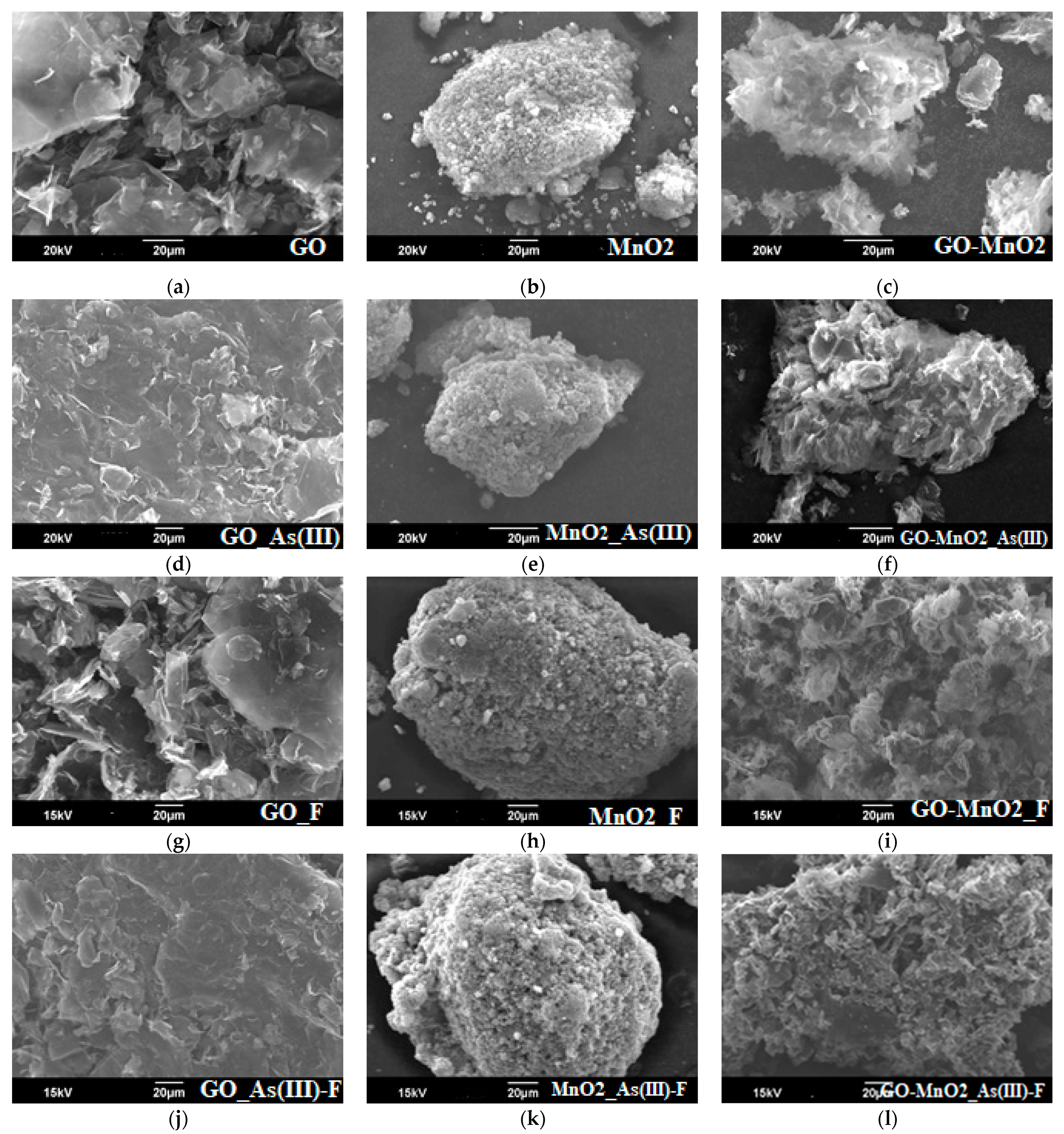
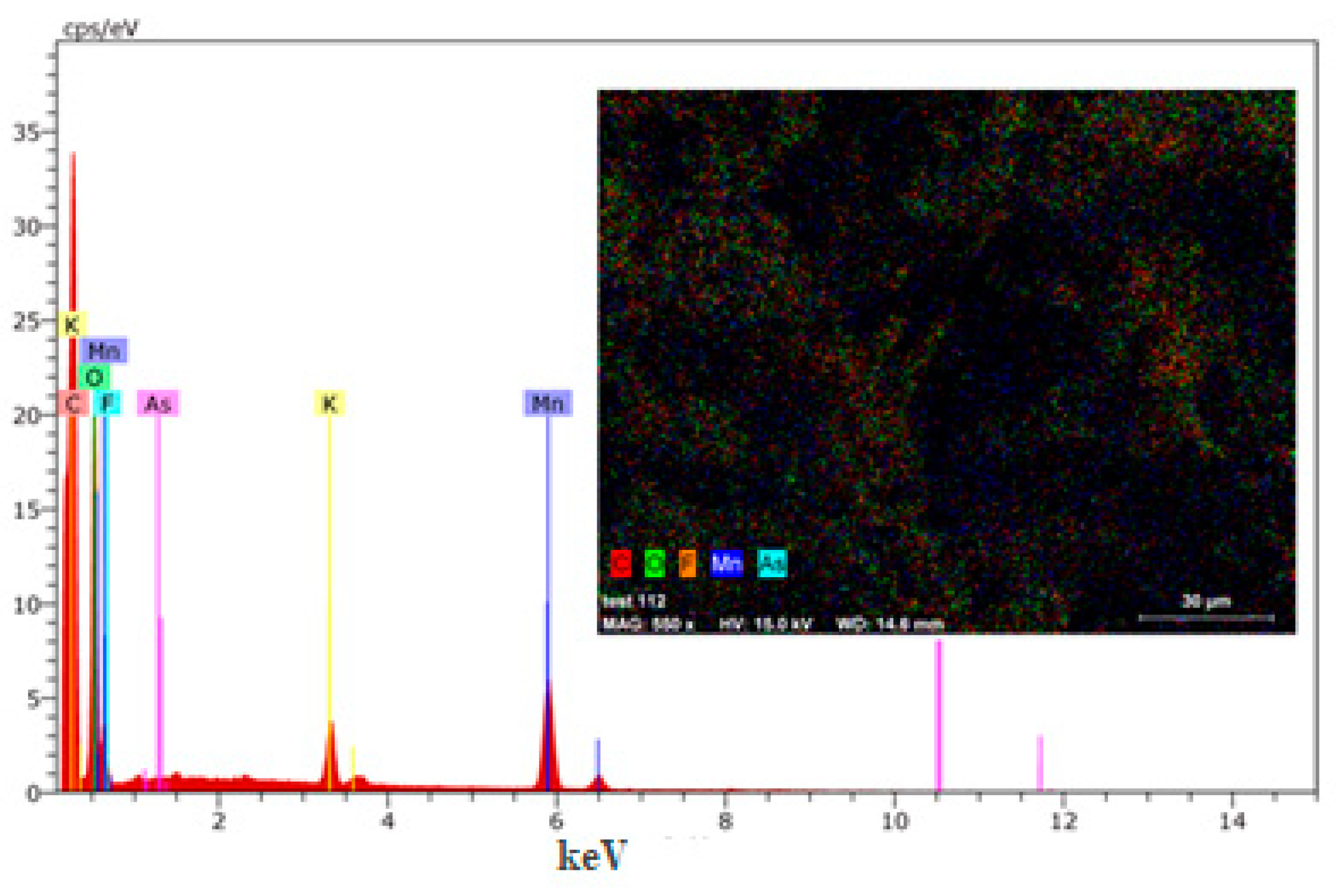
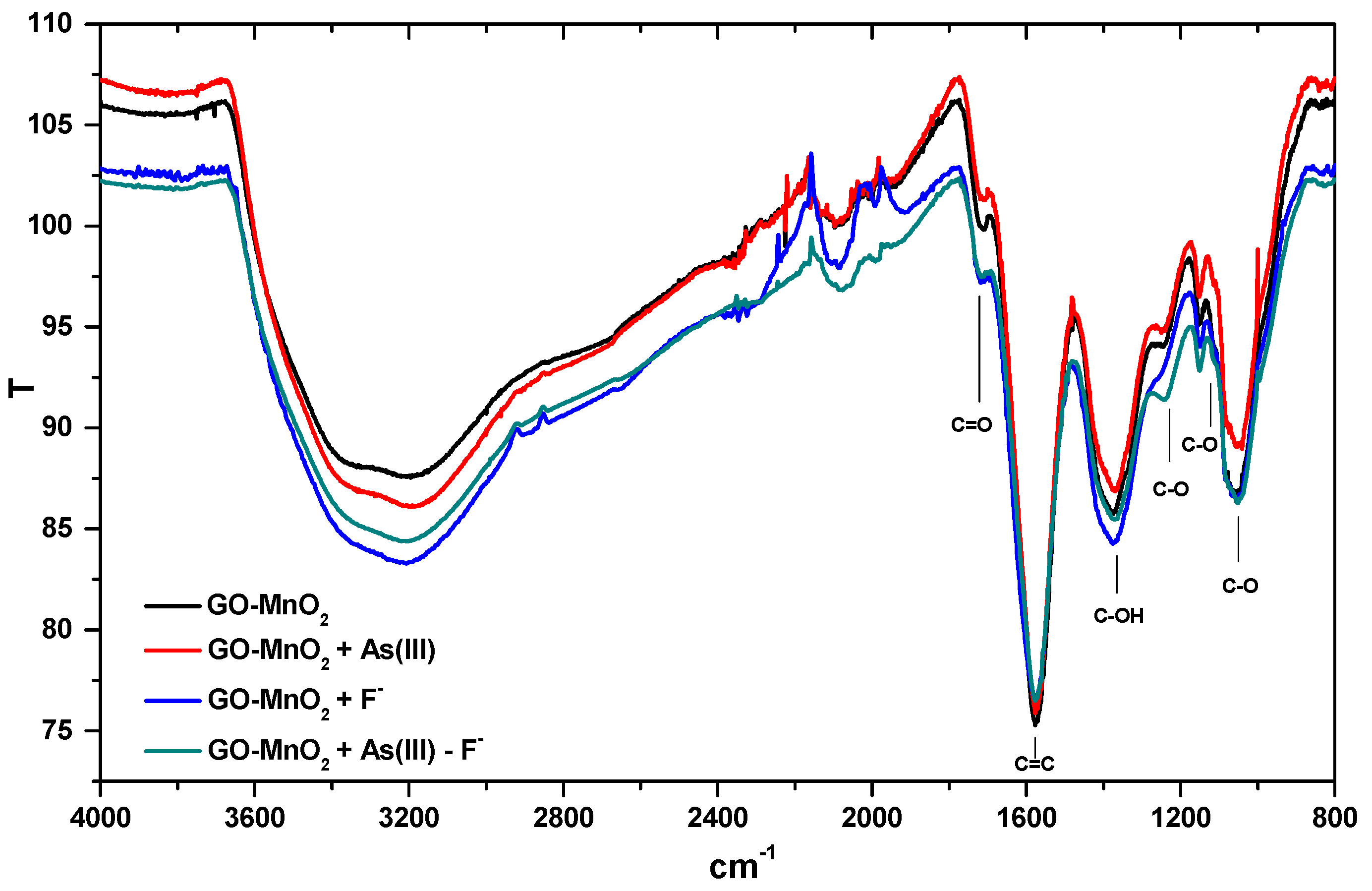
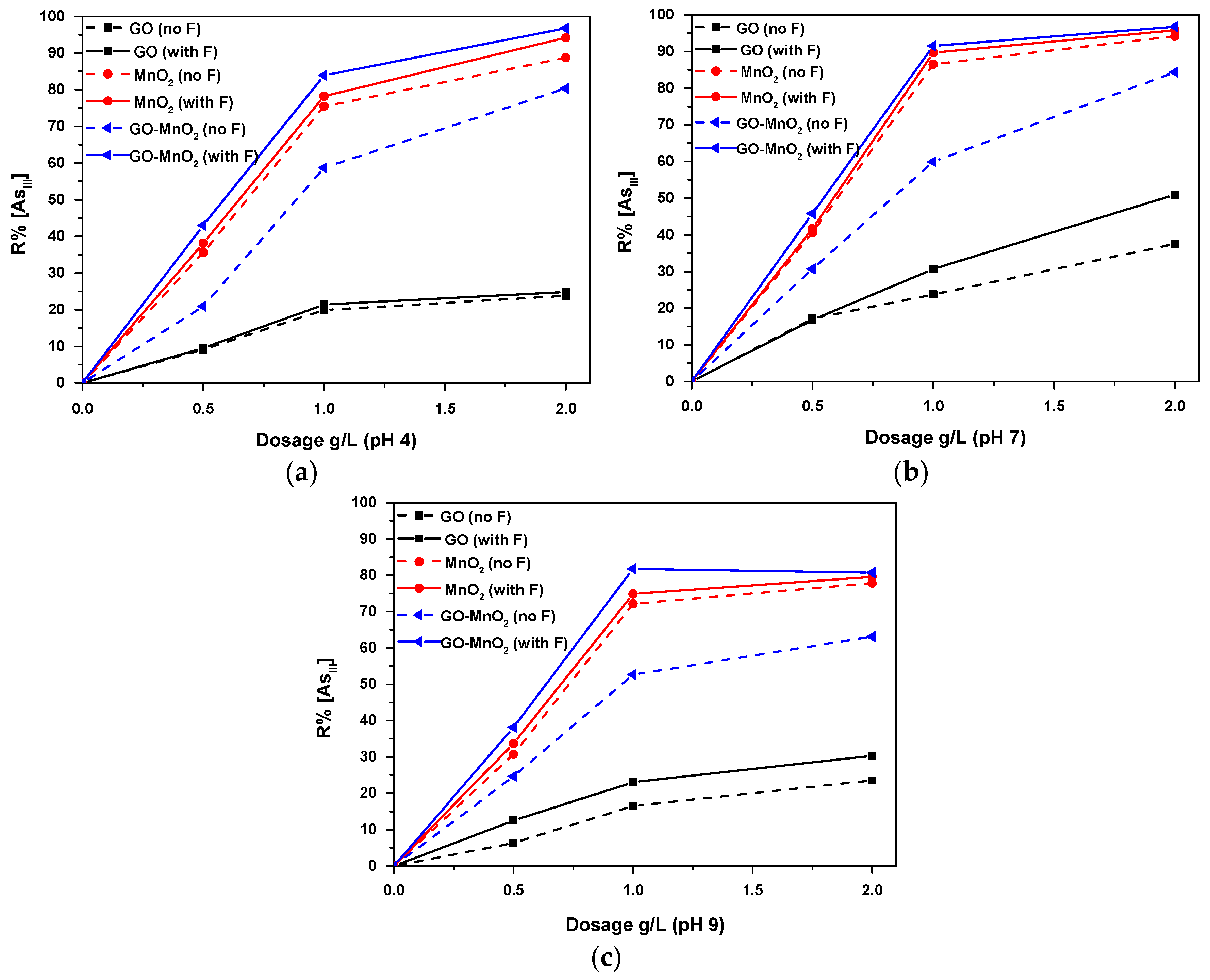
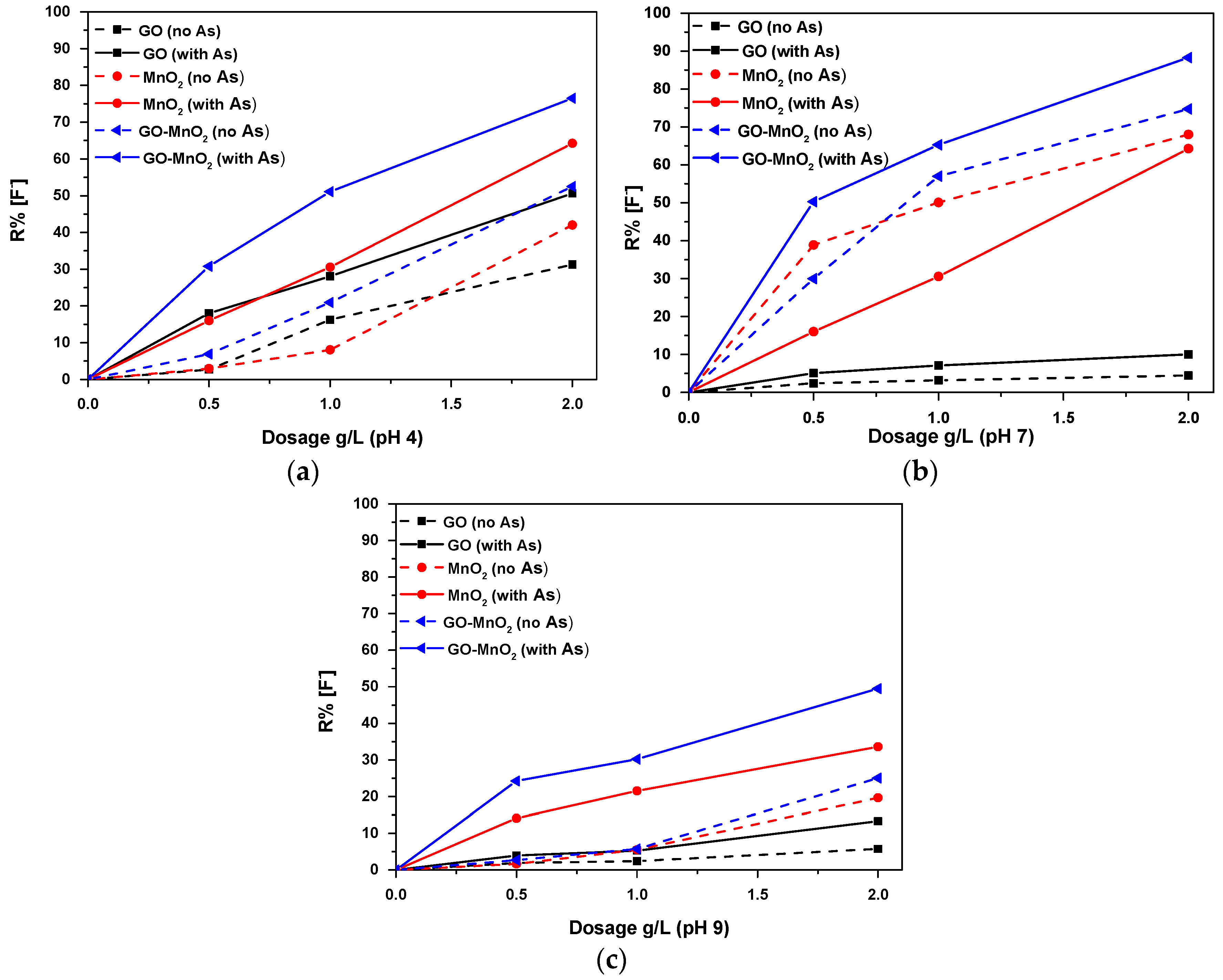
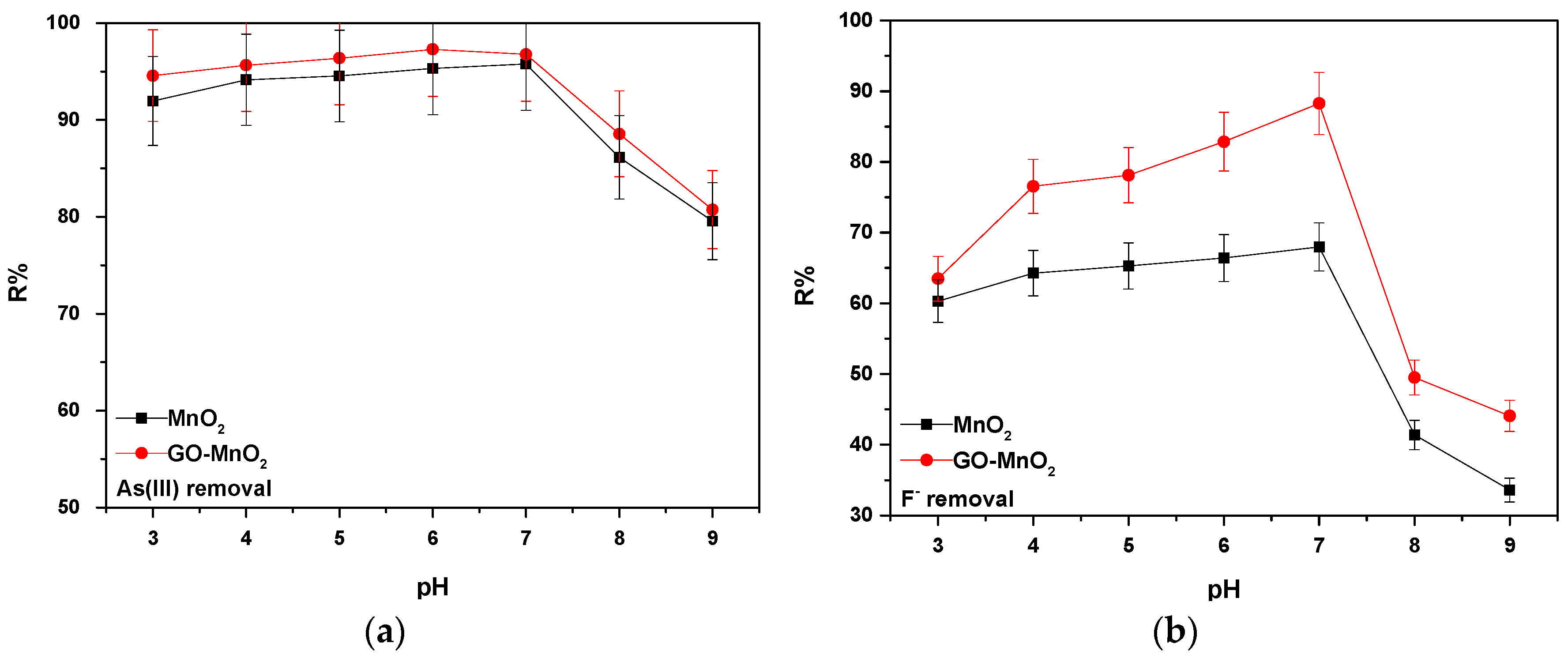
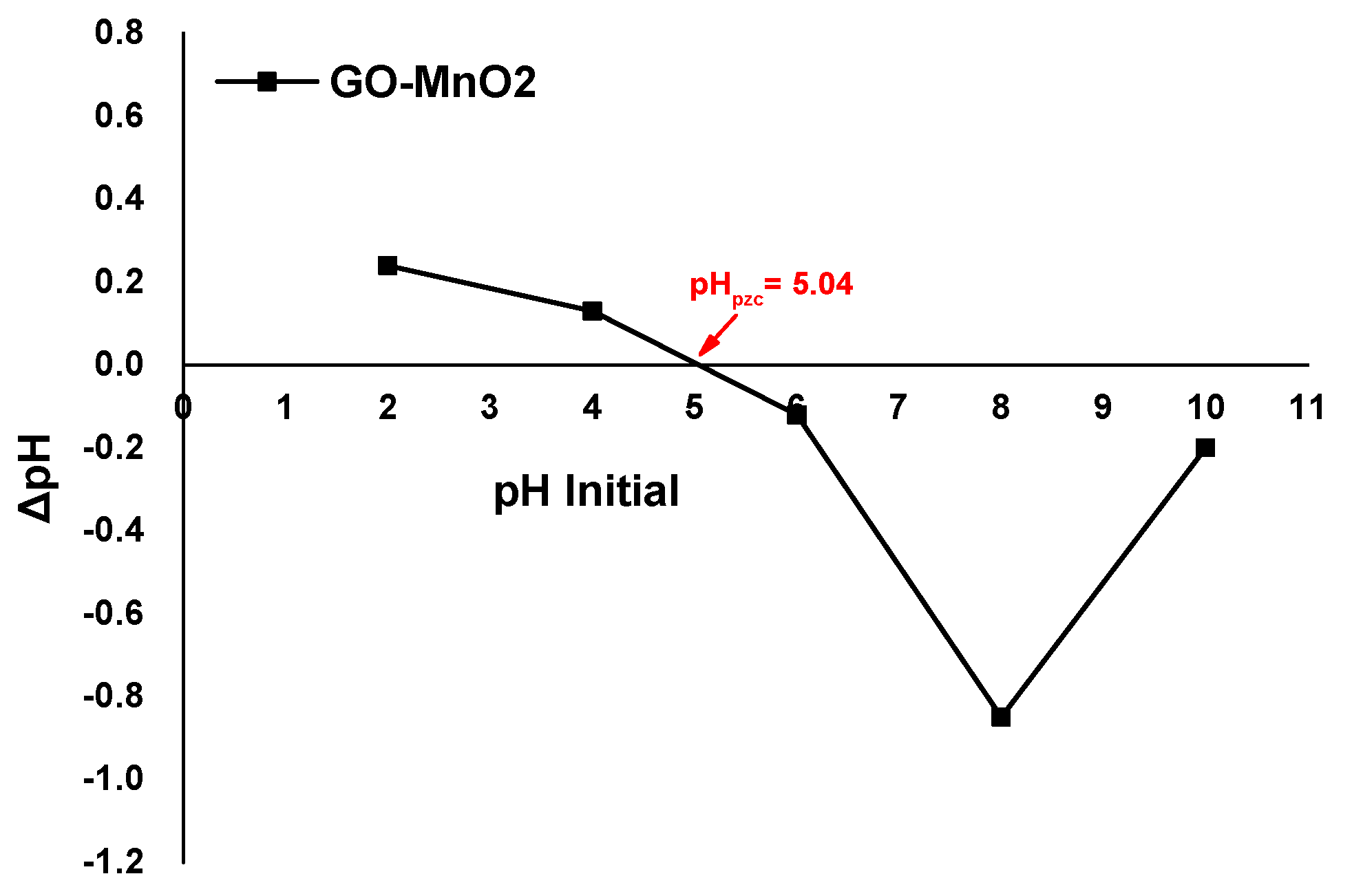
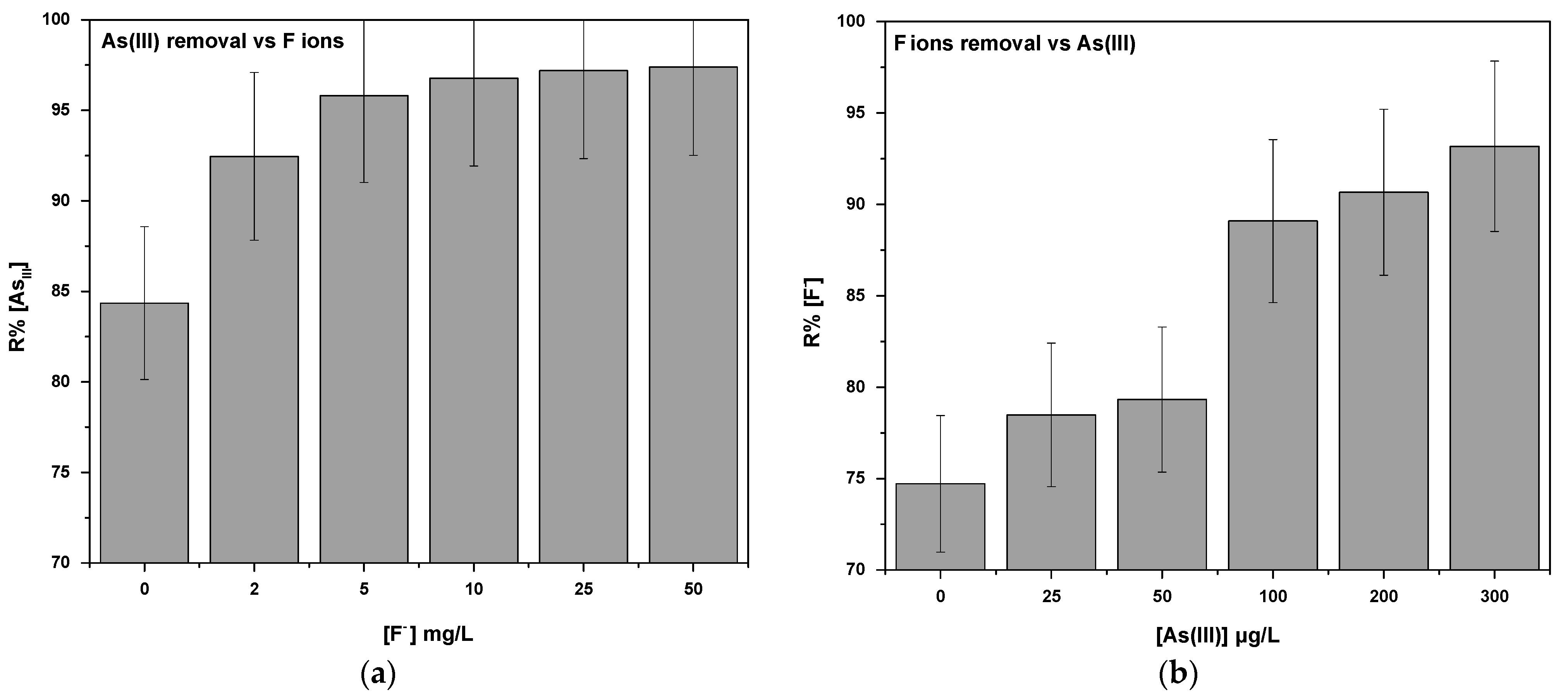
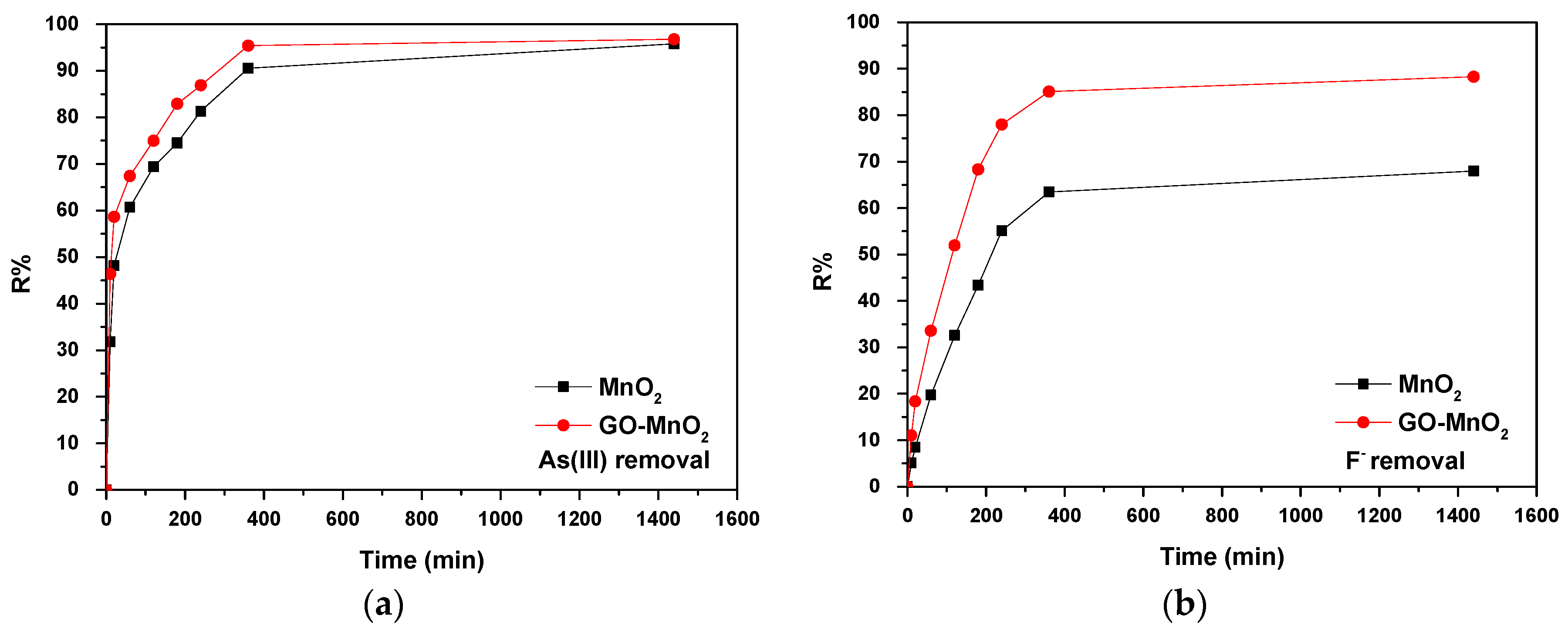
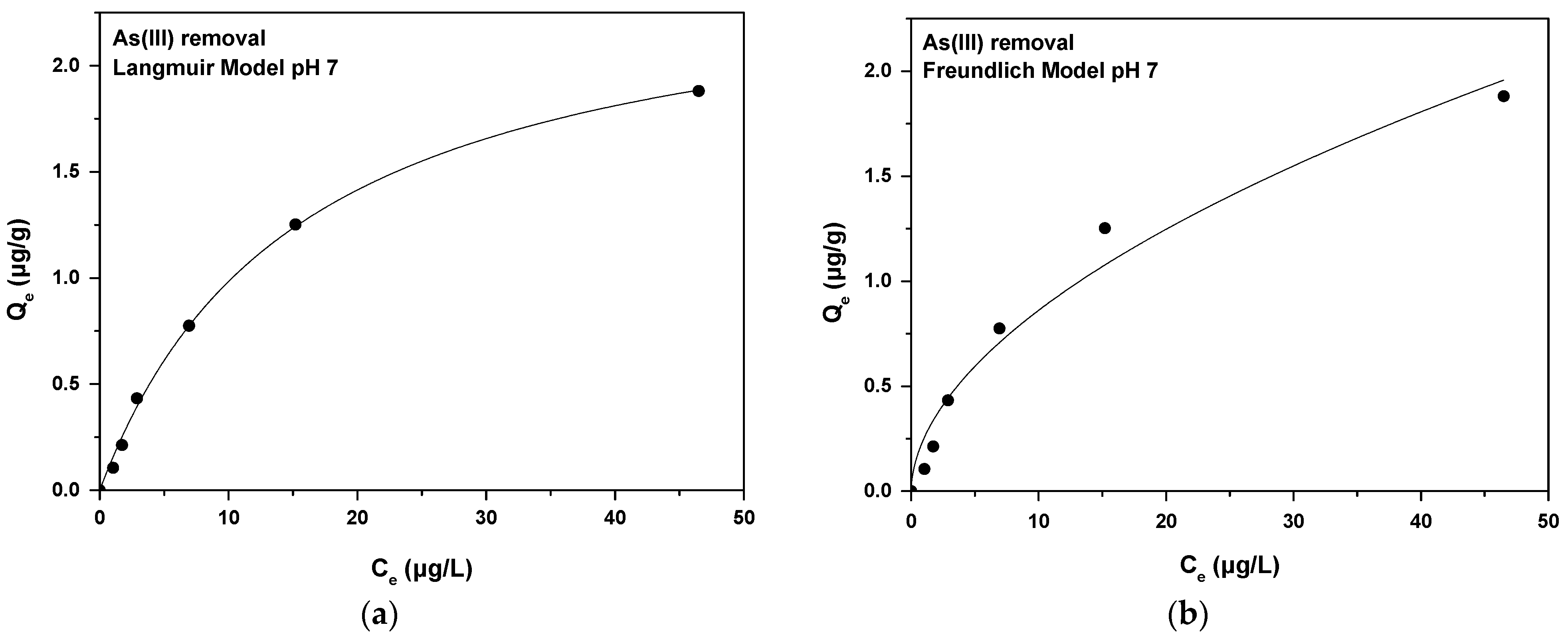
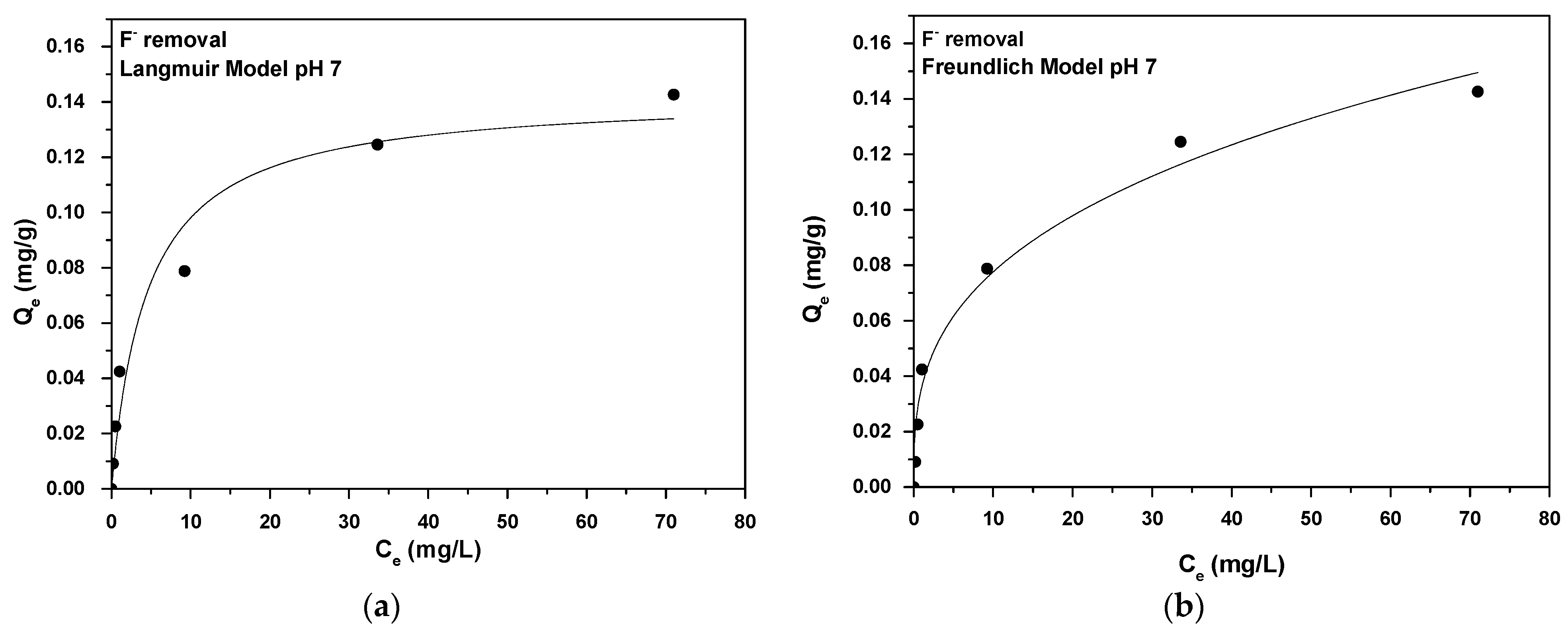
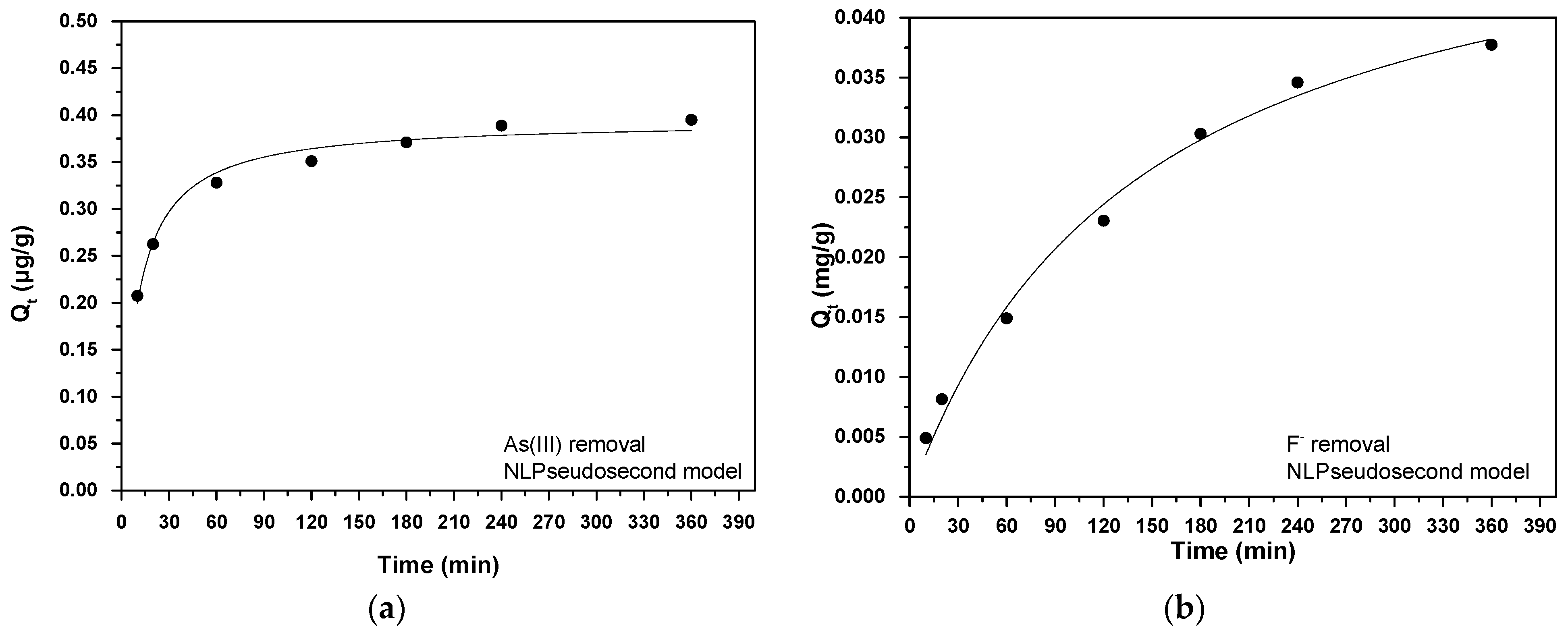
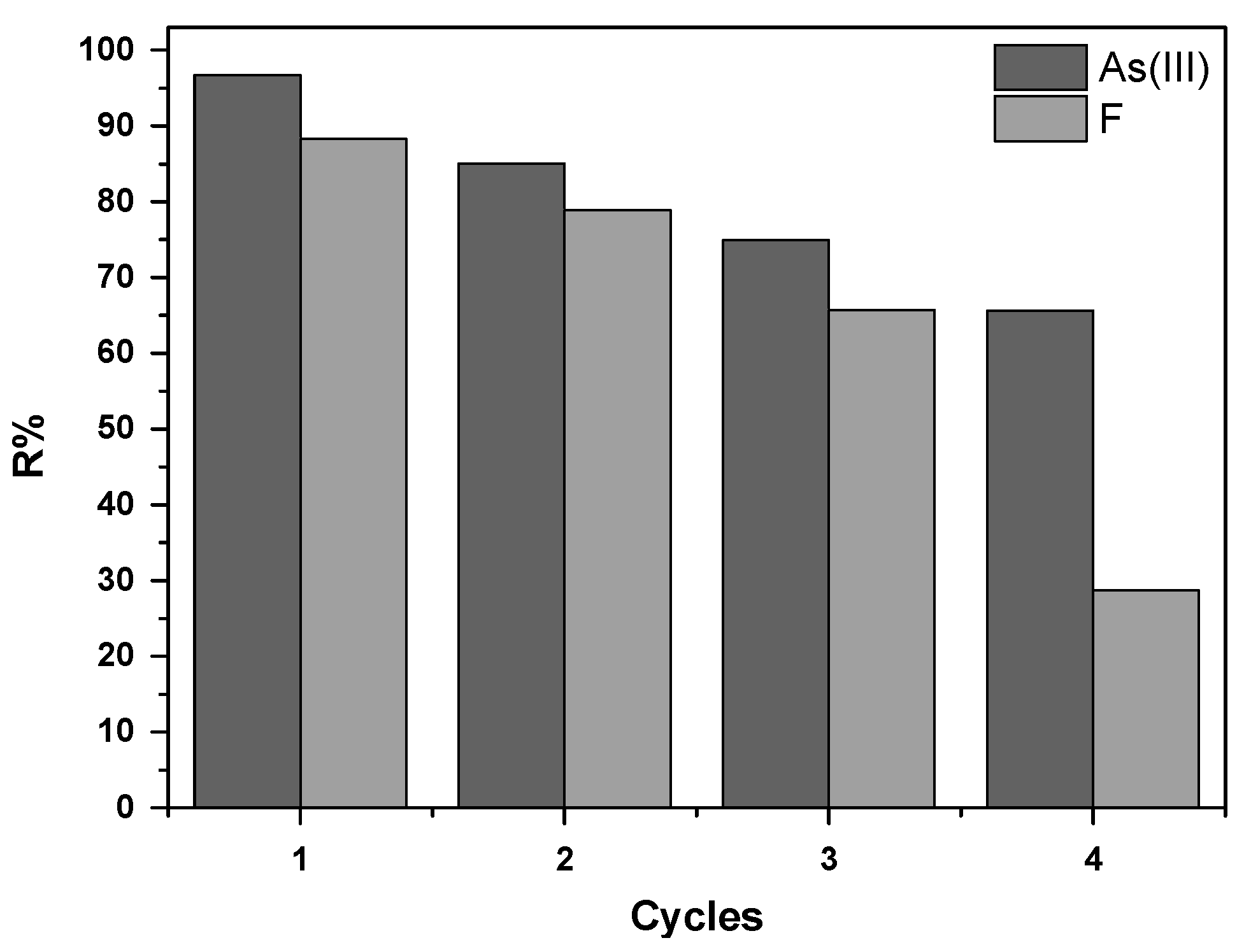
| % (w/w) | GO | MnO2 | GO-MnO2 |
| Carbon | 43.84 | - | 28.70 |
| Sulfur | 14.56 | - | - |
| Oxygen | 41.6 | 68.91 | 64.81 |
| Manganese | - | 27.86 | 3.93 |
| Potassium | - | 2.63 | 2.56 |
| Chlorine | - | 0.60 | - |
| % (w/w) | GO_As(III) | MnO2_As(III) | GO-MnO2_As(III) |
| Arsenic | 0.10 | 1.19 | 0.56 |
| Carbon | 75.93 | - | 26.89 |
| Sulfur | 0.57 | - | - |
| Oxygen | 23.39 | 58.77 | 63.38 |
| Manganese | - | 36.35 | 6.52 |
| Potassium | - | 3.68 | 2.64 |
| % (w/w) | GO_F− | MnO2_F− | GO-MnO2_F− |
| Carbon | 73.65 | - | 22.22 |
| Fluorine | 2.22 | 13.63 | 4.48 |
| Sulfur | 0.51 | - | - |
| Oxygen | 23.61 | 59.54 | 50.31 |
| Manganese | - | 24.74 | 19.61 |
| Potassium | - | 2.09 | 3.39 |
| % (w/w) | GO_ As(III)-F− | MnO2_ As(III)-F− | GO-MnO2_ As(III)-F− |
| Carbon | 73.21 | - | 22.07 |
| Arsenic | 0.07 | 2.01 | 4.24 |
| Fluorine | 1.78 | 0.51 | 8.38 |
| Sulfur | 0.36 | - | - |
| Silicon | 0.24 | - | - |
| Oxygen | 24.34 | 29.04 | 50.39 |
| Manganese | - | 63.05 | 12.31 |
| Potassium | - | 5.39 | 2.61 |
| Langmuir Isotherm Model | ||||
| Adsorbent | Qm (μg/g) | KL (L/g) | R2 | |
| GO-MnO2 | 2.52 | 0.0641 | 0.9975 | |
| Freundlich isotherm model | ||||
| Adsorbent | 1/n | n | KF (μg/g)(L/μg)1/n | R2 |
| GO-MnO2 | 0.5343 | 1.8716 | 0.2516 | 0.9665 |
| Langmuir Isotherm Model | ||||
| Adsorbent | Qm (mg/g) | KL (L/g) | R2 | |
| GO-MnO2 | 0.142 | 0.2208 | 0.9561 | |
| Freundlich isotherm model | ||||
| Adsorbent | 1/n | n | KF (mg/g)(L/mg)1/n | R2 |
| GO-MnO2 | 0.3344 | 2.9900 | 0.0359 | 0.9804 |
| Pseudo-Second Order Model (PSO) | ||||
| Adsorbent | Qe.exp (μg/g) | K2 (L/μg∙min) | Qe.cal (μg/g) | R2 |
| As(III) in presence of F− | ||||
| GO-MnO2 | 0.4331 | 0.2593 | 0.3939 | 0.9907 |
| Adsorbent | Qe.exp (mg/g) | K2 (L/mg∙min) | Qe.cal (mg/g) | R2 |
| F− in presence of As(III) | ||||
| GO-MnO2 | 0.0392 | 0.1325 | 0.0533 | 0.9895 |
Disclaimer/Publisher’s Note: The statements, opinions and data contained in all publications are solely those of the individual author(s) and contributor(s) and not of MDPI and/or the editor(s). MDPI and/or the editor(s) disclaim responsibility for any injury to people or property resulting from any ideas, methods, instructions or products referred to in the content. |
© 2023 by the authors. Licensee MDPI, Basel, Switzerland. This article is an open access article distributed under the terms and conditions of the Creative Commons Attribution (CC BY) license (https://creativecommons.org/licenses/by/4.0/).
Share and Cite
Tolkou, A.K.; Trikkaliotis, D.G.; Kyzas, G.Z.; Katsoyiannis, I.A.; Deliyanni, E.A. Simultaneous Removal of As(III) and Fluoride Ions from Water Using Manganese Oxide Supported on Graphene Nanostructures (GO-MnO2). Sustainability 2023, 15, 1179. https://doi.org/10.3390/su15021179
Tolkou AK, Trikkaliotis DG, Kyzas GZ, Katsoyiannis IA, Deliyanni EA. Simultaneous Removal of As(III) and Fluoride Ions from Water Using Manganese Oxide Supported on Graphene Nanostructures (GO-MnO2). Sustainability. 2023; 15(2):1179. https://doi.org/10.3390/su15021179
Chicago/Turabian StyleTolkou, Athanasia K., Dimitrios G. Trikkaliotis, George Z. Kyzas, Ioannis A. Katsoyiannis, and Eleni A. Deliyanni. 2023. "Simultaneous Removal of As(III) and Fluoride Ions from Water Using Manganese Oxide Supported on Graphene Nanostructures (GO-MnO2)" Sustainability 15, no. 2: 1179. https://doi.org/10.3390/su15021179
APA StyleTolkou, A. K., Trikkaliotis, D. G., Kyzas, G. Z., Katsoyiannis, I. A., & Deliyanni, E. A. (2023). Simultaneous Removal of As(III) and Fluoride Ions from Water Using Manganese Oxide Supported on Graphene Nanostructures (GO-MnO2). Sustainability, 15(2), 1179. https://doi.org/10.3390/su15021179










